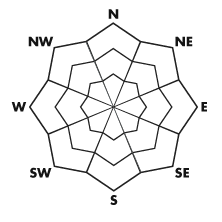


| Advisory: Salt Lake Area Mountains | Issued by Evelyn Lees for April 2, 2013 - 6:42am |
|---|
























 
Above 9,500 ft.
8,000-9,500 ft.
Below 8,000 ft.
|
bottom line The avalanche danger is CONSIDERABLE on mid and upper elevation slopes steeper than about 35 degrees. Long running new snow slides will be easy to trigger on steep slopes of all aspects, and debris piles will be deep. Daytime heating and possible sun will keep the new snow sensitive, with wet avalanches becoming possible this afternoon, especially at the mid elevations and on steep, sun lit slopes.
|
 |
special announcement Survey time!!
iPhone & iPad users: With help from Backcountry.com & Garafa, LLC, we now have a free mobile app that combines the best of the UAC advisories, observations, and weather summaries with National Weather Service products & UDOT road updates. This puts the tools you need for planning your day and your run in one handy mobile package. Check it out, tell your friends, and let us know what you think. http://utahavalanchecenter.org/apps
|
 |
current conditions Winter is back – a band of wrap around moisture stalled out over the Salt Lake and Park City mountains overnight, with storm totals a fairly even 9 to 13” at the upper elevations. Densities average about 8 to 10% at the higher elevations. Temperatures are in the mid-20s to low 30s this morning. The northwest to westerly winds are light, averaging in the 5 to 10 mph range, with even the high peaks averaging less than 10 mph. |
 |
recent activity Yesterday, the new snow was very sensitive, and I found it easy to trigger new snow sluffs in the 2” of new snow. In the upper elevations of Little Cottonwood Canyon, which had received 4” of new snow by yesterday afternoon, there was actually a small natural avalanche cycle. |
| type | aspect/elevation | characteristics |
|---|
 |
























 
Above 9,500 ft.
8,000-9,500 ft.
Below 8,000 ft.
|
|
|
description
I expect new snow avalanches to be easy to trigger on steep slopes of all aspects. The surprise may be how much snow these slides entrain and how far they run, especially on long, steep slopes or in confined paths like gullies. These slides could pack a lot of punch, be large enough to catch and carry a person, with debris piles deeper than expected. These avalanches could also be a strange hybrid in places – start out as dry snow slabs, and by the time they reach the bottom of a long slope, have some characteristics of a wet snow slide. |
| type | aspect/elevation | characteristics |
|---|
 |
























 
Above 9,500 ft.
8,000-9,500 ft.
Below 8,000 ft.
|
|
|
description
Start and finish your backcountry travels early today – day time heating and direct or filtered sun will rapidly warm the new snow. Wet sluffs will become easy to trigger as the day progresses. Again, these slides could be longer running and have deeper debris piles than you would expect.
|
 |
weather Light snowfall will continue this morning as the low pressure system slowly moves to the east. An additional 1 to 3” of snow is possible, with less frequent, but perhaps more intense, snow showers this afternoon. Occasional sun is also possible this afternoon. Temperatures will warm to near 40 at 8,000’ and to near 30 at 10,000’. The northerly winds will remain light today, averaging in the 5 to 15 mph range, with occasional gusts along the highest ridges to 30 mph. High pressure with a warming trend will rebuild over the area on Wednesday and Thursday, followed by an unsettled pattern Friday through the weekend, with periods of snow possible. |
| general annoucements Go to http://www.backcountry.com/utah-avalanche-center to get EVEN MORE DISCOUNTED tickets from our partners at Beaver Mountain and Sundance. All proceeds benefit the Utah Avalanche Center. If you trigger an avalanche in the backcountry - especially if you are adjacent to a ski area – please call the following teams to alert them to the slide and whether anyone is missing or not. Rescue teams can be exposed to significant hazard when responding to avalanches, and do not want to do so when unneeded. Thanks. Salt Lake and Park City – Alta Central (801-742-2033), Canyons Resort Dispatch (435-615-3322) Ogden – Snowbasin Patrol Dispatch (801-620-1017) Powder Mountain Ski Patrol Dispatch (801-745-3772 ex 123) Provo – Sundance Patrol Dispatch (801-223-4150) Dawn Patrol Forecast Hotline, updated by 05:30: 888-999-4019 option 8. Twitter Updates for your mobile phone - DETAILS Daily observations are frequently posted by 10 pm each evening. Subscribe to the daily avalanche advisory e-mail click HERE. UDOT canyon closures UDOT at (801) 975-4838 Wasatch Powderbird Guides does daily updates about where they'll be operating on this blog http://powderbird.blogspot.com/ . Remember your information can save lives. If you see anything we should know about, please participate in the creation of our own community avalanche advisory by submitting snow and avalanche conditions. You can also call us at 801-524-5304 or 800-662-4140, email by clicking HERE, or include #utavy in your tweet. Donate to your favorite non-profit –The Friends of the Utah Avalanche Center. The UAC depends on contributions from users like you to support our work. For a print version of this advisory click HERE. This advisory is produced by the U.S. Forest Service, which is solely responsible for its content. It describes only general avalanche conditions and local variations always exist. Specific terrain and route finding decisions should always be based on skills learned in a field-based avalanche class. |